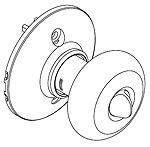Donald Norman's seminal book The Design of Everyday Things devotes a significant amount of time to the design of doors and locks -- and, it turns out, for good reason. It's amazing how so seemingly simple an item of everyday life can be made complicated by non-intuitive design. (The design of my car's power lock system provided enough fodder for a 12-page paper.)
By virtue of our proximity to the local airport, my wife and I recently were awarded a substantial amount of sound-proofing work on our home, including specially designed outer doors. The doors themselves are fantastic, from a sound-proofing and insulation standpoint. However, almost immediately, our downstairs tenant started complaining that the locks were "sticking" and were extremely difficult to open from the outside (she almost broke two keys trying to do so).
The inside knobs look like this:

Nothing too complicated here -- based on my life's experience, you rotate the small switch in the center of the inner knob clockwise to keep the outer knob from turning (thereby locking the door), thus requiring a key to unlock it. Turning the switch back counterclockwise allows the outer knob to turn, allowing entry without a key.
Or so I thought.
Turns out, our locks come from a new series design. Locking the door as described above is accomplished by pressing and depressing the switch in the center. Turning it clockwise and counterclockwise activates a new "pickproof" feature that keeps the door from being opened even if a key is used.
The worker who was called to the house explained the operation of the locks to my wife and tenant, then commented that most elderly customers are having so much trouble using the new locks that they're asking to have the old locks reinstalled, an expense incurred by the management of the soundproofing program.
How's that for wasted time and money?
No comments:
Post a Comment